Study on the Effect of Judgment Excitation Mode to Relieve Driving Fatigue Based on MF-DFA
Abstract
1. Introduction
2. Materials and Methods
2.1. Subjects
2.2. Procedure and EEG Recording
2.3. JEM
2.4. Methods
2.4.1. MF-DFA
2.4.2. Statistical Analysis Algorithm
3. Results
3.1. Subjective Questionnaire
3.2. Multifractal Detrended Fluctuation Analysis
3.2.1. Hurst Exponent
3.2.2. Multifractal Spectrum
3.3. Emergency Stop Test
4. Discussion
4.1. Previous Studies and This Study
4.2. Limitations and Future Research Lines
5. Conclusions
Author Contributions
Funding
Institutional Review Board Statement
Informed Consent Statement
Data Availability Statement
Conflicts of Interest
References
- Jiang, K.; Ling, F.; Feng, Z. Why do drivers continue driving while fatigued? An application of the theory of planned behaviour. Transp. Res. Part A Policy Pract. 2017, 98, 141–149. [Google Scholar] [CrossRef]
- Husain, N.A.; Mohamad, J.; Idris, M.A. Daily emotional demands on traffic crashes among taxi drivers: Fatigue and safety motivation as mediators. IATSS Res. 2019, 43, 268–276. [Google Scholar] [CrossRef]
- Ma, Y.; Chen, B.; Li, R. Driving fatigue detection from EEG using a modified PCANet method. Comput. Intell. Neurosci. 2019, 2019, 867–876. [Google Scholar] [CrossRef]
- Zhao, S.F.; Guo, W.; Zhang, C. Extraction method of driver’s mental component based on empirical mode decomposition and approximate entropy statistic characteristic in vehicle running state. J. Adv. Transp. 2017, 2017, 1–14. [Google Scholar] [CrossRef]
- Hu, H.; Gao, Z.; Yu, Z. An experimental driving simulator study of unintentional lane departure. Adv. Mech. Eng. 2017, 9, 1687814017726290. [Google Scholar] [CrossRef]
- Chang, H.; Yoon, B. Potential of highly automated vehicles for monitoring fatigued drivers and explaining traffic accidents on motorway sections. J. Adv. Transp. 2020, 2020, 3610923. [Google Scholar] [CrossRef]
- Li, K.; Gong, Y.; Ren, Z. A fatigue driving detection algorithm based on facial multi-feature fusion. IEEE Access 2020, 8, 101244–101259. [Google Scholar] [CrossRef]
- You, F.; Gong, Y.; Tu, H. A fatigue driving detection algorithm based on facial motion information entropy. J. Adv. Transp. 2020, 2020, 1–17. [Google Scholar] [CrossRef]
- Liu, W.; Qian, J.; Yao, Z. Convolutional two-stream network using multi-facial feature fusion for driver fatigue detection. Future Int. 2019, 11, 115. [Google Scholar] [CrossRef]
- Zhao, C.; Zhao, M.; Liu, J. Electroencephalogram and electrocardiograph assessment of mental fatigue in a driving simulator. Accid. Anal. Prev. 2012, 45, 83–90. [Google Scholar] [CrossRef]
- Wang, F.; Zhang, X.; Fu, R. EEG characteristic analysis of coach bus drivers based on brain connectivity as revealed via a graph theoretical network. RSC Adv. 2018, 8, 29745–29755. [Google Scholar] [CrossRef]
- Wang, F.; Xu, Q.; Fu, R. Study on the effect of man-machine response mode to relieve driving fatigue based on EEG and EOG. Sensors 2019, 19, 4883. [Google Scholar] [CrossRef]
- Wang, F.; Wang, H.; Fu, R. Real-time ECG-based detection of fatigue driving using sample entropy. Entropy 2018, 20, 196. [Google Scholar] [CrossRef]
- Cerquera, A.; Vollebregt, M.A.; Arns, M. Nonlinear Recurrent Dynamics and Long-Term Nonstationarities in EEG Alpha Cortical Activity: Implications for Choosing Adequate Segment Length in Nonlinear EEG Analyses. Clin. EEG Neurosci. 2018, 49, 71–78. [Google Scholar] [CrossRef]
- Zorick, T.; Mandelkern, M.A. Multifractal Detrended Fluctuation Analysis of Human EEG: Preliminary Investigation and Comparison with the Wavelet Transform Modulus Maxima Technique. PLoS ONE 2013, 8, e68360. [Google Scholar]
- Mandelbrot, B. How long is the coast of Britain? Statistical self-similarity and fractional dimension. Science 1967, 156, 636–638. [Google Scholar] [CrossRef]
- Mandelbort, B.B. Possible Refinements Of The Lognormal Hypothesis Concerning The Distribution Of Energy Dissipation In Intermitent Turbulence. In Statistical Models and Turbulence; Springer: Berlin, Germany, 1972. [Google Scholar]
- Kantelhardt, J.W.; Zschiegner, S.A.; Koscielny-Bunde, E. Multifractal detrended fluctuation analysis of nonstationary time series. Phys. A Stat. Mech. Its Appl. 2002, 316, 87–114. [Google Scholar] [CrossRef]
- Wang, J.; Shao, W.; Kim, J. Ecg classification comparison between mf-dfa and mf-dxa. Fractals-Complex Geom. Patterns Scaling Nat. Soc. 2021, 29, 2150029. [Google Scholar] [CrossRef]
- Roca, J.L.; Rodríguez-Bermúdez, G.; Fernández-Martínez, M. Fractal-based techniques for physiological time series: An updated approach. Open Phys. 2018, 16, 741–750. [Google Scholar] [CrossRef]
- Zorick, T.; Gaines, K.D.; Berenji, G.R. Information Transfer and Multifractal Analysis of EEG in Mild Blast-Induced TBI. Comput. Math. Methods Med. 2021, 2021, 6638724. [Google Scholar] [CrossRef]
- Zhou, Y.W.; Liu, J.L.; Yu, Z.G. Fractal and complex network analyses of protein molecular dynamics. Phys. A Stat. Mech. Its Appl. 2014, 416, 21–32. [Google Scholar] [CrossRef][Green Version]
- Zorick, T.; Landers, J.; Leuchter, A. EEG multifractal analysis correlates with cognitive testing scores and clinical staging in mild cognitive impairment. J. Clin. Neurosci. 2020, 76, 195–200. [Google Scholar] [CrossRef] [PubMed]
- Wang, J.; Shao, W.; Kim, J. Automated classification for brain MRIs based on 2D MF-DFA method. Fractals 2020, 28, 2050109. [Google Scholar] [CrossRef]
- Matic, V.; Cherian, P.J.; Koolen, N. Objective differentiation of neonatal EEG background grades using detrended fluctuation analysis. Front. Hum. Neurosci. 2015, 9, 189. [Google Scholar] [CrossRef] [PubMed]
- Chiesi, M.; Guermandi, M.; Placati, S.; Scarselli, E.F.; Guerrieri, R. Creamino: A Cost-Effective, Open-Source EEG-Based BCI System. IEEE Trans. Biomed. Eng. 2019, 66, 900–909. [Google Scholar] [CrossRef]
- Bueno, A.P.A.; Sato, J.R.; Hornberger, M. Eye tracking—The overlooked method to measure cognition in neurodegeneration? Neuropsychologia 2019, 133, 107191. [Google Scholar] [CrossRef]
- Katona, J. Analyse the Readability of LINQ Code using an Eye-Tracking-based Evaluation. Acta Polytech. Hung. 2021, 18, 193–215. [Google Scholar] [CrossRef]
- Lopes-Silva, J.P.; Lima-Silva, A.E.; Bertuzzi, R. Influence of music on performance and psychophysiological responses during moderate-intensity exercise preceded by fatigue. Physiol. Behav. 2015, 139, 274–280. [Google Scholar] [CrossRef]
- Li, R.; Chen, Y.V.; Zhang, L. Effect of music tempo on long-distance driving: Which tempo is the most effective at reducing fatigue? i-Perception 2019, 10, 2041669519861982. [Google Scholar] [CrossRef]
- Guo, W.; Ren, J.; Wang, B. Effects of relaxing music on mental fatigue induced by a continuous performance task: Behavioral and ERPs evidence. PLoS ONE 2015, 10, e0136446. [Google Scholar] [CrossRef]
- Li, Z.; Wu, F.; Shao, H. Does the fragrance of essential oils alleviate the fatigue induced by exercise? A biochemical indicator test in rats. Evid.-Based Complementary Altern. Med. 2017, 2017, 5027372. [Google Scholar] [CrossRef] [PubMed]
- Are Female Drivers Better than Male Drivers? Look at the Big data Given by Hangzhou Traffic Police Department. Available online: https://hznews.hangzhou.com.cn/chengshi/content/2021-03/08/content_7923216.html (accessed on 27 August 2022).
- Guo, J.; Weng, D.; Zhang, Z. Subjective and objective evaluation of visual fatigue caused by continuous and discontinuous use of HMDs. J. Soc. Inf. Disp. 2019, 27, 108–119. [Google Scholar] [CrossRef]
- Piasna, A. Scheduled to work hard: The relationship between non-standard working hours and work intensity among European workers (2005–2015). Hum. Resour. Manag. J. 2018, 28, 167–181. [Google Scholar] [CrossRef]
- Matthews, G.; Desmond, P.A. Task-induced fatigue states and simulated driving performance. Q. J. Exp. Psychol. Sect. A 2002, 55, 659–686. [Google Scholar] [CrossRef] [PubMed]
- Wang, H.; Zhang, C.; Shi, T. Real-time EEG-based detection of fatigue driving danger for accident prediction. Int. J. Neural Syst. 2015, 25, 1550002. [Google Scholar] [CrossRef]
- Gershon, P.; Ronen, A.; Oron-Gilad, T. The effects of an interactive cognitive task (ICT) in suppressing fatigue symptoms in driving. Transp. Res. Part F Traffic Psychol. Behav. 2009, 12, 21–28. [Google Scholar] [CrossRef]
- Evstigneeva, M.; Aleksandrov, A.; Mathiassen, S.E. Concurrent cognitive task may improve motor work performance and reduce muscle fatigue. Work 2012, 41, 2893–2896. [Google Scholar] [CrossRef]
- Oron-Gilad, T.; Ronen, A.; Shinar, D. Alertness maintaining tasks (AMTs) while driving. Accid. Anal. Prev. 2008, 40, 851–860. [Google Scholar] [CrossRef]
- Takayama, L.; Nass, C. Assessing the effectiveness of interactive media in improving drowsy driver safety. Hum. Factors 2008, 50, 772–781. [Google Scholar] [CrossRef]
- Wang, Y.K.; Jung, T.P.; Lin, C.T. Theta and alpha oscillations in attentional interaction during distracted driving. Front. Behav. Neurosci. 2018, 12, 3. [Google Scholar] [CrossRef]
- Huang, Z.; Huang, X. A study on the application of voice interaction in automotive human machine interface experience design. In AIP Conference Proceedings, Proceedings of the 2nd International Conference on Advances in Materials; AIP Publishing LLC: New York, NY, USA, 18 April 2018; Volume 1955, p. 40074. [Google Scholar]
- Lee, Y.C.; Lee, J.D.; Ng Boyle, L. The interaction of cognitive load and attention-directing cues in driving. Hum. Factors 2009, 51, 271–280. [Google Scholar] [CrossRef]
- Kantelhardt, J.W.; Koscielny-Bunde, E.; Rego, H.H.; Havlin, S.; Bunde, A. Detecting long-range correlations with detrended fluctuation analysis. Phys. A Stat. Mech. Its Appl. 2001, 295, 441–454. [Google Scholar] [CrossRef]
- Mandelbrot, B.B.; Van Ness, J.W. Fractional Brownian motions, fractional noises and applications. SIAM Rev. 1968, 10, 422–437. [Google Scholar] [CrossRef]
- Olmo, G.; Farolfi, F.; Miola, F. The reliability of objective fatigue measures in Multiple Sclerosis Patients. Biomed. Signal Processing Control. 2020, 56, 101696. [Google Scholar] [CrossRef]
- Shaw, P.K.; Saha, D.; Ghosh, S. Investigation of multifractal nature of floating potential fluctuations obtained from a dc glow discharge magnetized plasma. Phys. A Stat. Mech. Its Appl. 2017, 469, 363–371. [Google Scholar] [CrossRef]
- Shimizu, Y.U.; Thurner, S.; Ehrenberger, K. Multifractal spectra as a measure of complexity in human posture. Fractals 2002, 10, 103–116. [Google Scholar] [CrossRef]
- Zhang, G.; Yau, K.K.W.; Zhang, X. Traffic accidents involving fatigue driving and their extent of casualties. Accid. Anal. Prev. 2016, 87, 34–42. [Google Scholar] [CrossRef]
- Wang, F.; Lu, B.; Kang, X. Research on driving fatigue alleviation using interesting auditory stimulation based on VMD-MMSE. Entropy 2021, 23, 1209. [Google Scholar] [CrossRef]
- Geng, S.; Zhou, W.; Yuan, Q. EEG non-linear feature extraction using correlation dimension and Hurst exponent. Neurol. Res. 2011, 33, 908–912. [Google Scholar] [CrossRef] [PubMed]
- Wang, F.; Wang, H. Study of driving fatigue alleviation by transcutaneous acupoints electrical stimulations. Sci. World J. 2014, 2014, 450249. [Google Scholar] [CrossRef]
- Sweeney, D.; Quinlan, L.R.; Browne, P. Applicability and tolerability of electrical stimulation applied to the upper and lower leg skin surface for cueing applications in Parkinson’s disease. Med. Eng. Phys. 2021, 87, 73–81. [Google Scholar] [CrossRef]
- Wörle, J.; Metz, B.; Baumann, M. Sleep inertia in automated driving: Post-sleep take-over and driving performance. Accid. Anal. Prev. 2021, 150, 105918. [Google Scholar] [CrossRef]
- Pan, Y.; Koyama, S.; Nagase, A. The Effects of Aroma on Product Experience-Analyzing the Product Experience of the Toy Blocks with Different Aromas. Int. J. Affect. Eng. 2020, 19, 1–10. [Google Scholar] [CrossRef]
- Ashnagar, Z.; Shadmehr, A.; Jalaei, S. The effects of acute bout of cycling on auditory & visual reaction times. J. Bodyw. Mov. Ther. 2015, 19, 268–272. [Google Scholar] [PubMed]
- Ferraro, F.R. No evidence of reaction time slowing in autism spectrum disorder. Autism 2016, 20, 116–122. [Google Scholar] [CrossRef]
- Richey, J.E.; Phillips, J.S.; Schunn, C.D. Is the link from working memory to analogy causal? No analogy improvements following working memory training gains. PLoS ONE 2014, 9, e106616. [Google Scholar]
- Dunning, D.L.; Holmes, J.; Gathercole, S.E. Does working memory training lead to generalized improvements in children with low working memory? A randomized controlled trial. Dev. Sci. 2013, 16, 915–925. [Google Scholar] [CrossRef]
- Robinson, C.W.; Chandra, M.; Sinnett, S. Existence of competing modality dominances. Atten. Percept. Psychophys. 2016, 78, 1104–1114. [Google Scholar] [CrossRef]
- Prabhakar, G.; Ramakrishnan, A.; Madan, M. Interactive gaze and finger controlled HUD for cars. J. Multimodal User Interfaces 2020, 14, 101–121. [Google Scholar] [CrossRef]
- Xiang, S.; Nie, F.; Meng, G. Discriminative least squares regression for multiclass classification and feature selection. IEEE Trans. Neural Netw. Learn. Syst. 2012, 23, 1738–1754. [Google Scholar] [CrossRef]
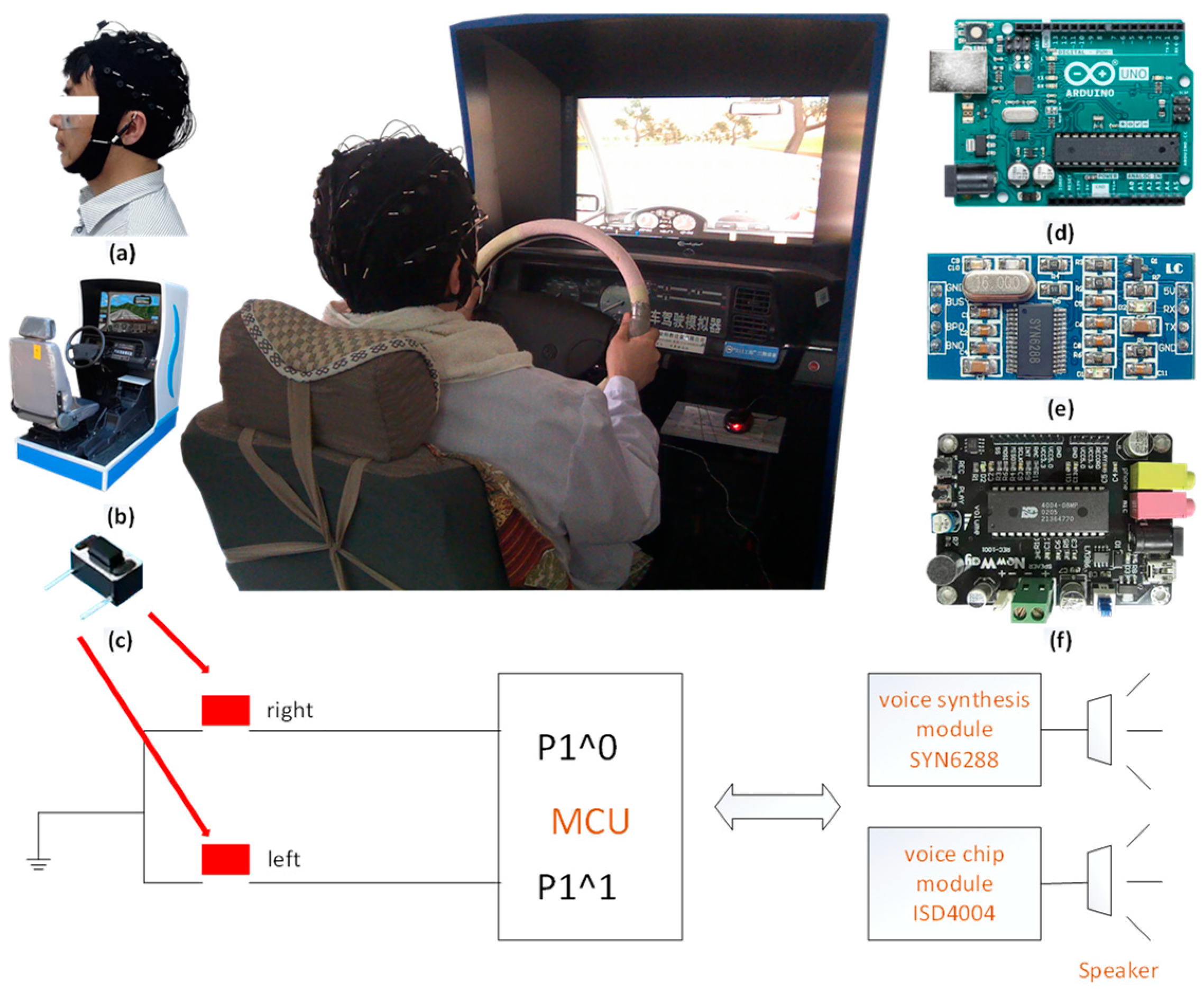

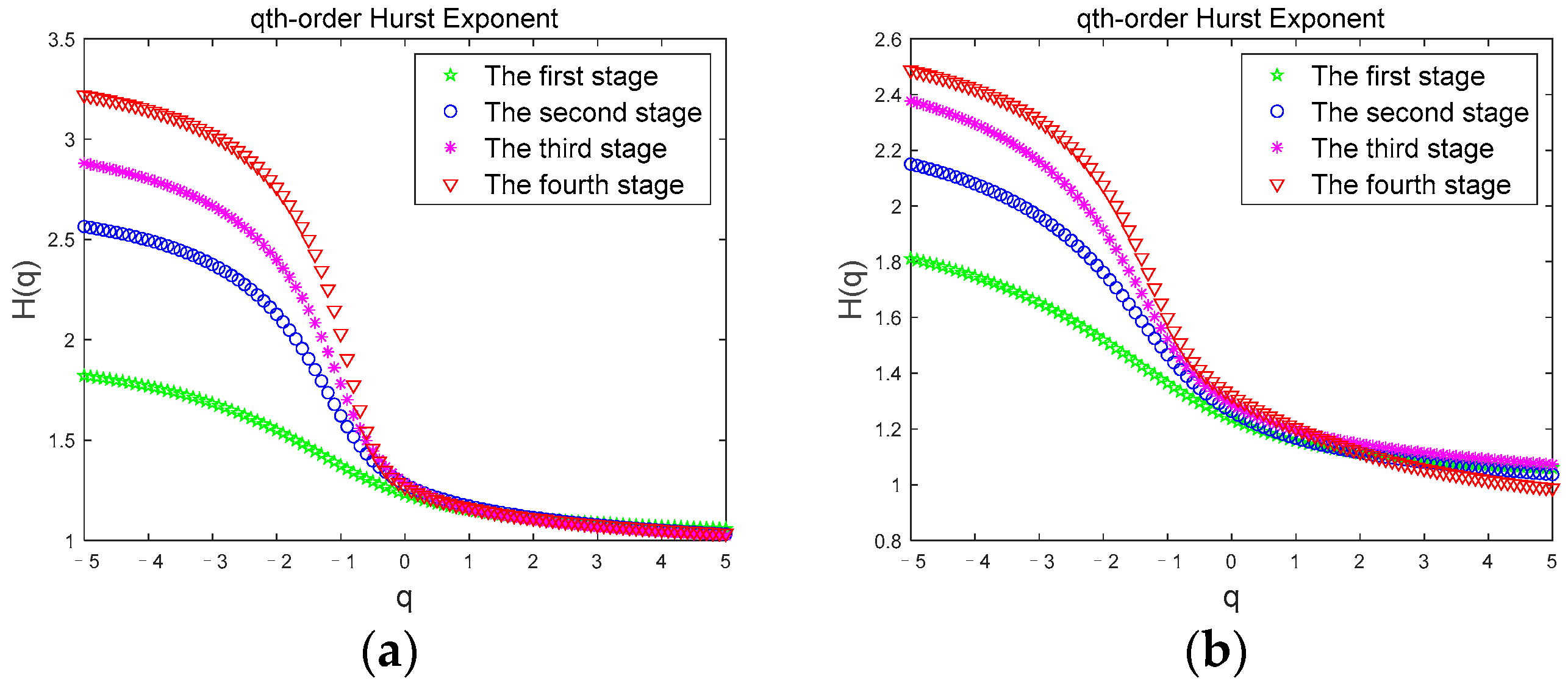
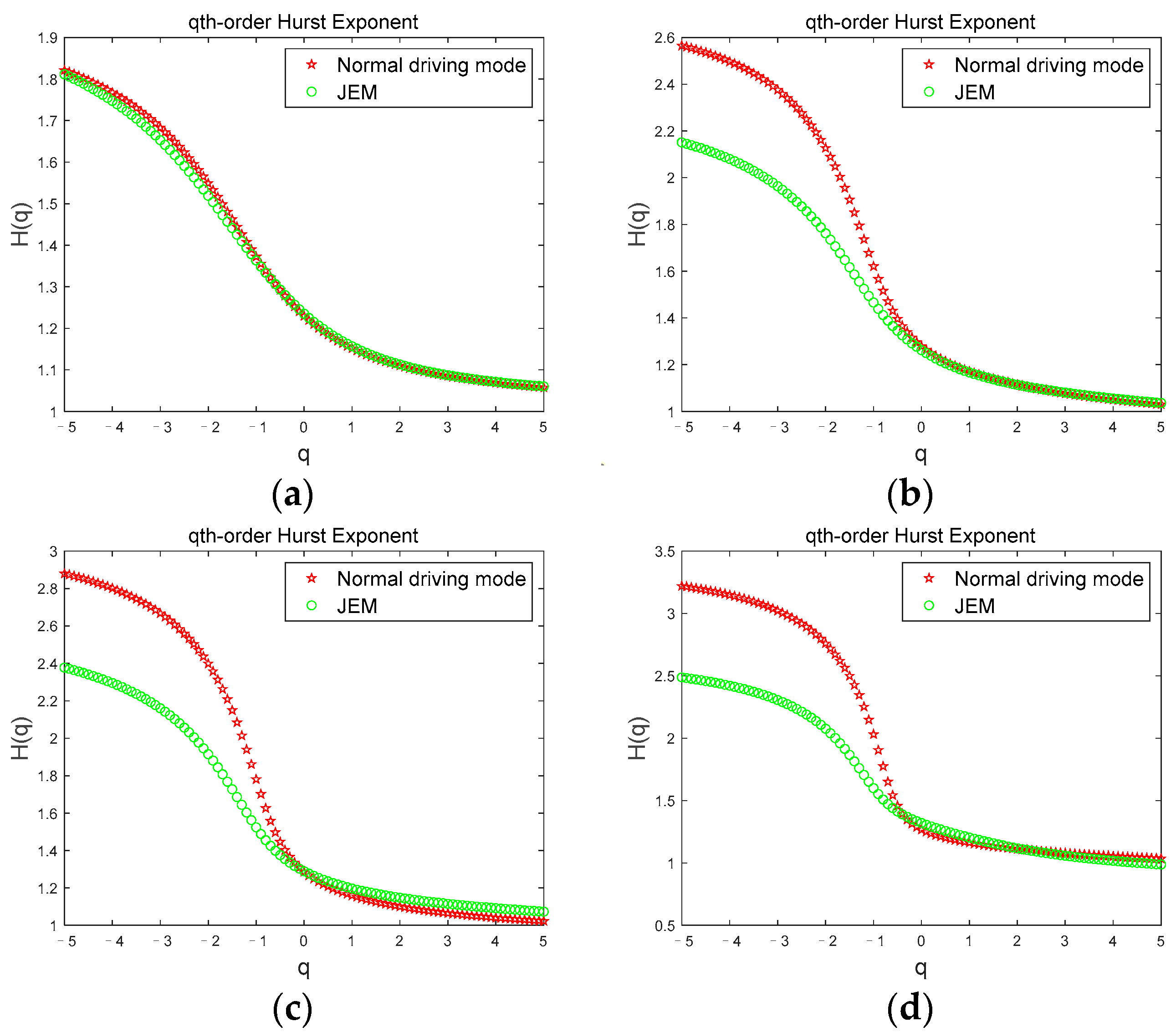


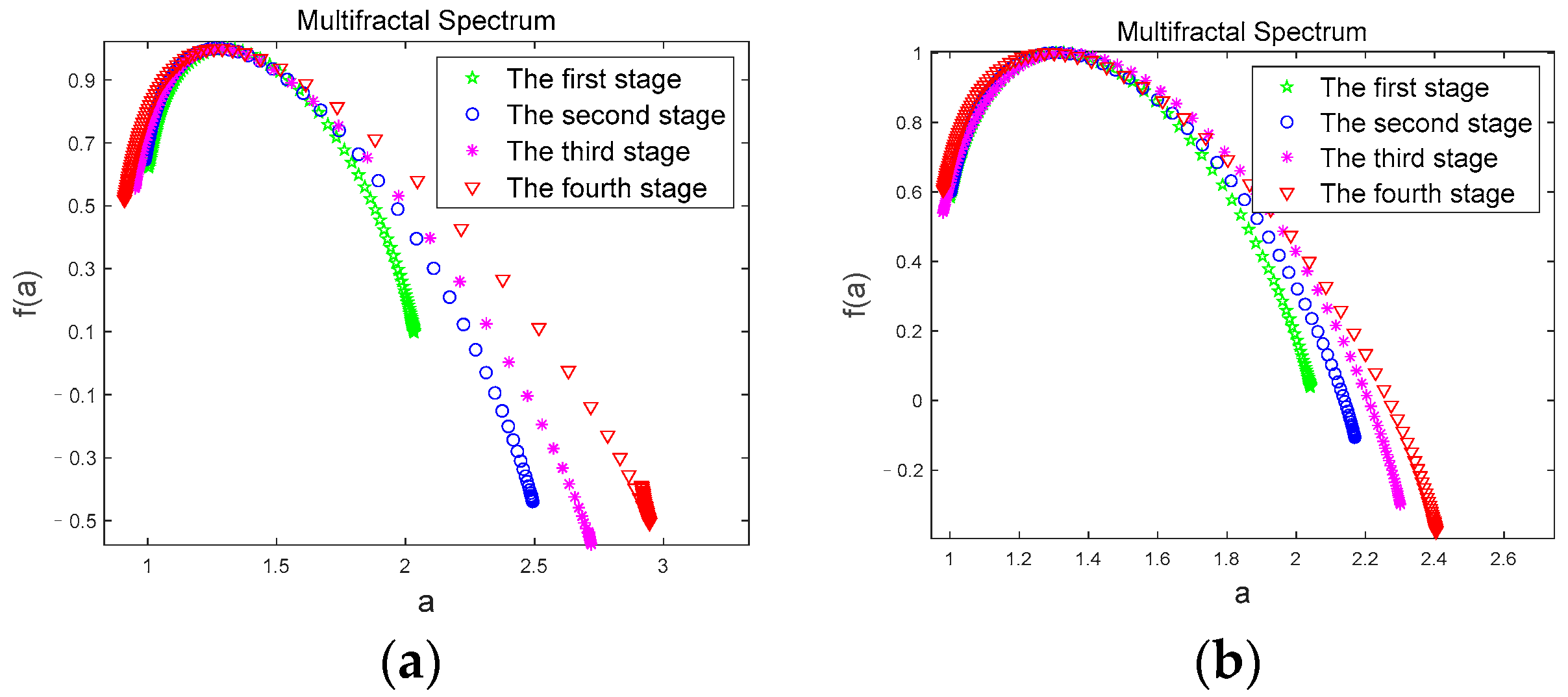
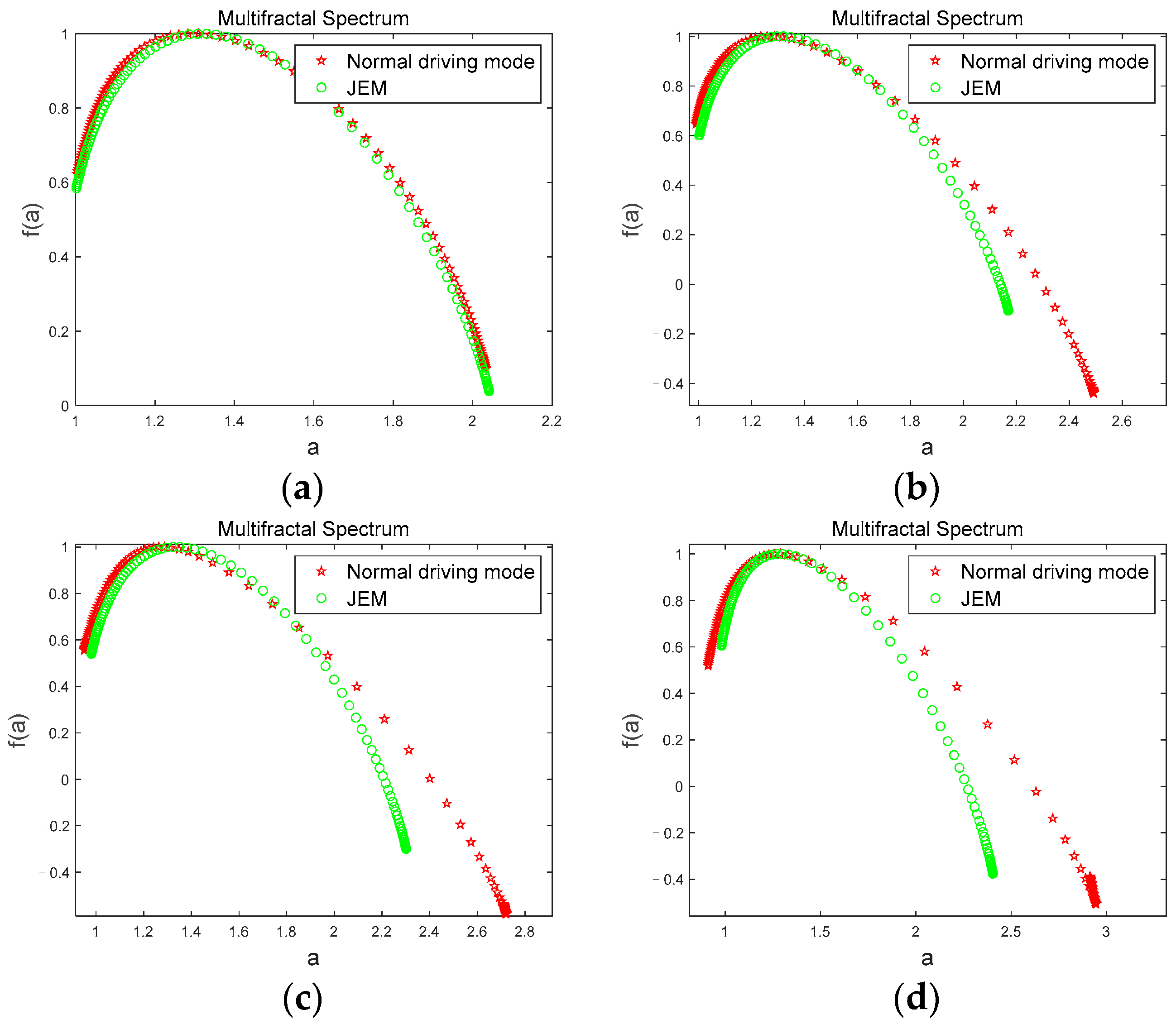


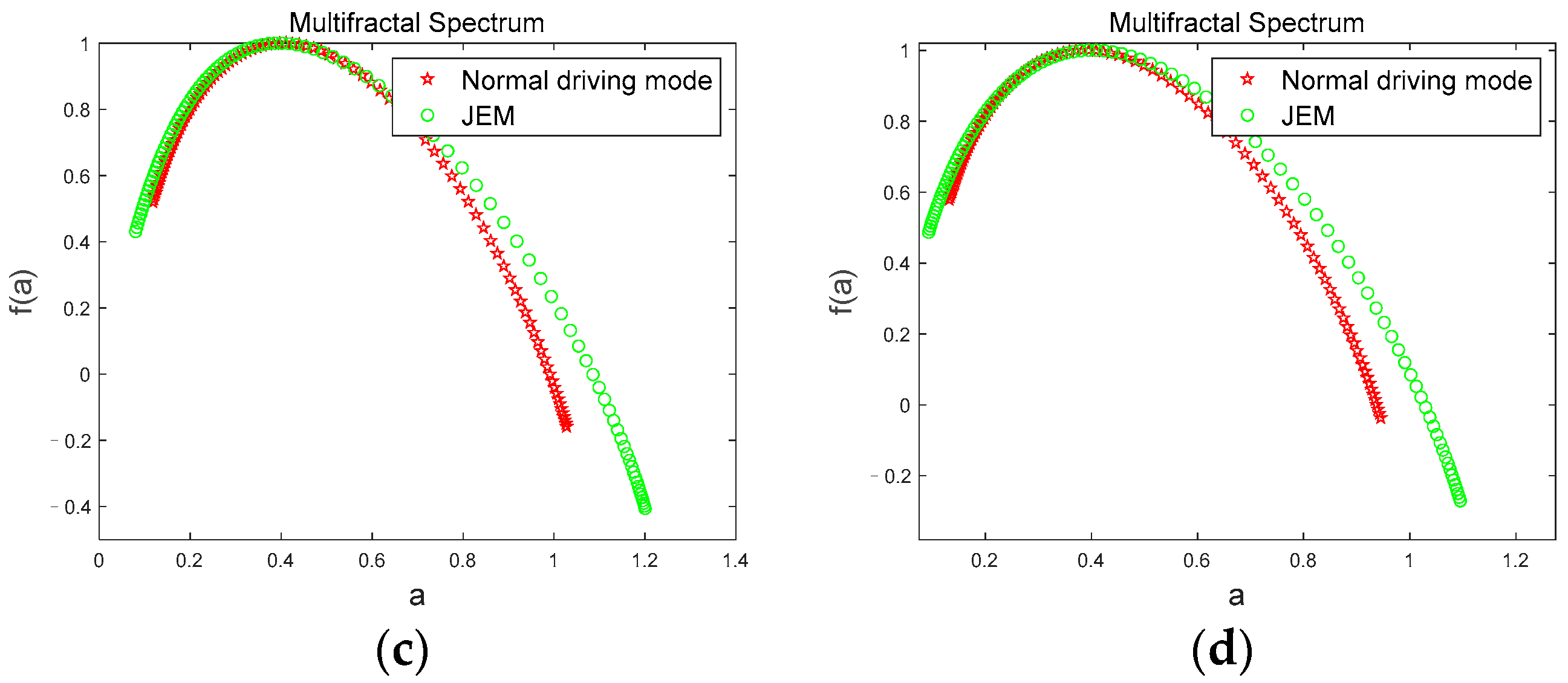
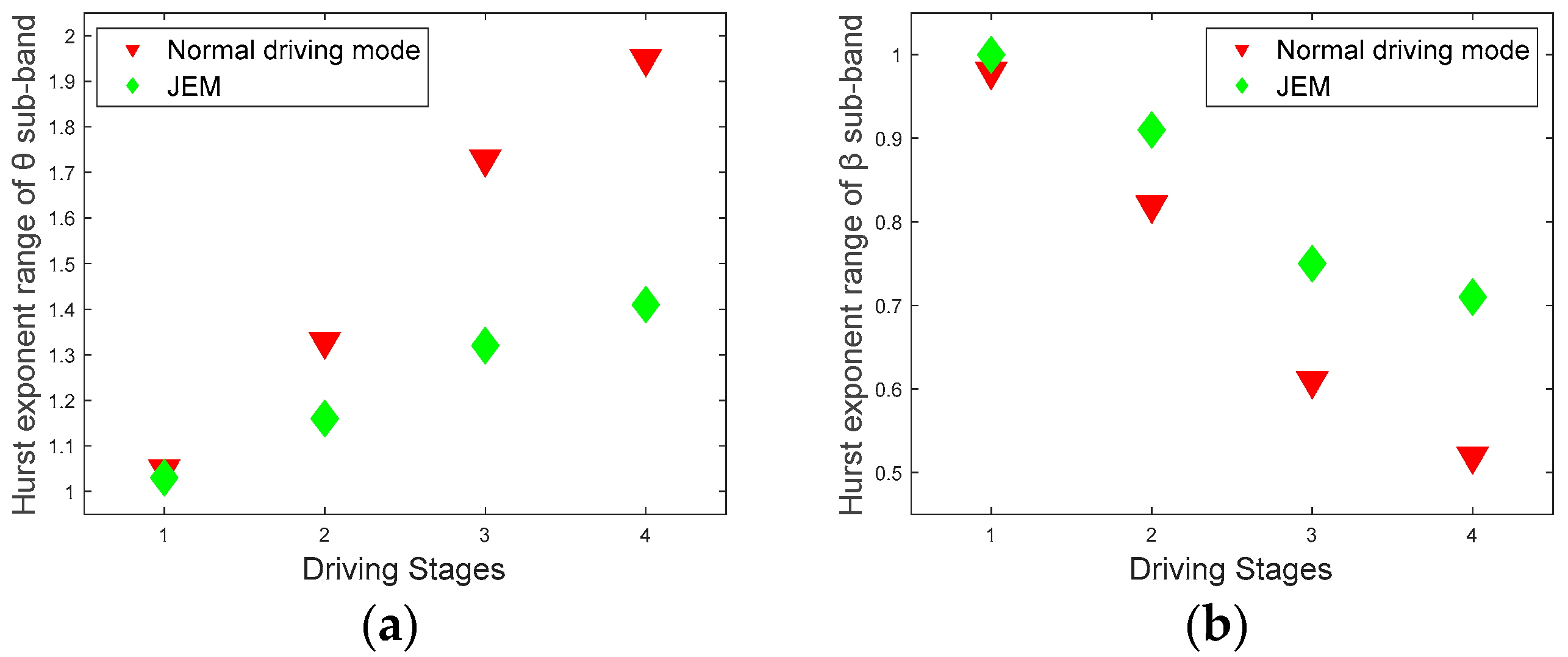


| Title 1 | Normal Driving Mode | Musical Stimulation | JEM |
|---|---|---|---|
| Hit the vehicle | 6.5 | 5.6 | 3.2 |
| Hit the building | 4.7 | 2.1 | 2.7 |
| Driving deviation | 5.6 | 5.2 | 4.8 |
| Running a red light | 8.2 | 9.6 | 7.5 |
| Speeding | 6.6 | 6.9 | 4.1 |
| Gear mismatch | 7.2 | 5.8 | 5.2 |
| Incorrect use of turn signals | 4.5 | 2.3 | 1.1 |
| Abnormal flameout | 11.3 | 7.2 | 3.6 |
Publisher’s Note: MDPI stays neutral with regard to jurisdictional claims in published maps and institutional affiliations. |
© 2022 by the authors. Licensee MDPI, Basel, Switzerland. This article is an open access article distributed under the terms and conditions of the Creative Commons Attribution (CC BY) license (https://creativecommons.org/licenses/by/4.0/).
Share and Cite
Wang, F.; Wang, H.; Zhou, X.; Fu, R. Study on the Effect of Judgment Excitation Mode to Relieve Driving Fatigue Based on MF-DFA. Brain Sci. 2022, 12, 1199. https://doi.org/10.3390/brainsci12091199
Wang F, Wang H, Zhou X, Fu R. Study on the Effect of Judgment Excitation Mode to Relieve Driving Fatigue Based on MF-DFA. Brain Sciences. 2022; 12(9):1199. https://doi.org/10.3390/brainsci12091199
Chicago/Turabian StyleWang, Fuwang, Hao Wang, Xin Zhou, and Rongrong Fu. 2022. "Study on the Effect of Judgment Excitation Mode to Relieve Driving Fatigue Based on MF-DFA" Brain Sciences 12, no. 9: 1199. https://doi.org/10.3390/brainsci12091199
APA StyleWang, F., Wang, H., Zhou, X., & Fu, R. (2022). Study on the Effect of Judgment Excitation Mode to Relieve Driving Fatigue Based on MF-DFA. Brain Sciences, 12(9), 1199. https://doi.org/10.3390/brainsci12091199







